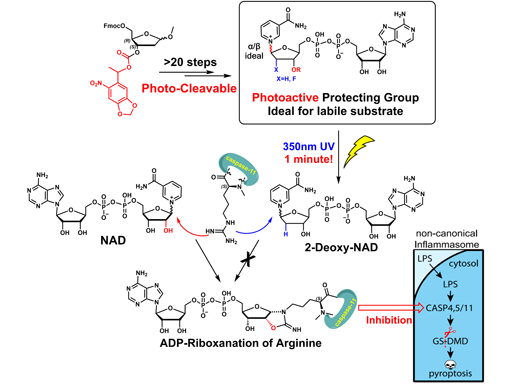Shigella evades pyroptosis by arginine ADP-riboxanation of caspase-11
Zilin Li, Wang Liu, Jiaqi Fu, Sen Cheng, Yue Xu, Zhiqiang Wang, Xiaofan Liu, Xuyan Shi, Yaxin Liu, Xiangbing Qi, Xiaoyun Liu, Jingjin Ding & Feng Shao
Mouse caspase-11 and human caspase-4 and caspase-5 recognize cytosolic lipopolysaccharide (LPS) to induce pyroptosis by cleaving the pore-forming protein GSDMD1–5. This non-canonical inflammasome defends against Gram-negative bacteria6,7. Shigella flexneri, which causes bacillary dysentery, lives freely within the host cytosol where these caspases reside. However, the role of caspase-11- mediated pyroptosis in S. flexneri infection is unknown. Here we show that caspase-11 did not protect mice from S. flexneri infection, in contrast to infection with another cytosolic bacterium, Burkholderia thailandensis8. S. flexneri evaded pyroptosis mediated by caspase-11 or caspase 4 (hereafter referred to as caspase-11/4) using a type III secretion system (T3SS) effector, OspC3. OspC3, but not its paralogues OspC1 and 2, covalently modified caspase-11/4; although it used the NAD+ donor, this modification was not ADP-ribosylation. Biochemical dissections uncovered an ADPriboxanation modification on Arg314 and Arg310 in caspase-4 and caspase-11, respectively. The enzymatic activity was shared by OspC1 and 2, whose ankyrin-repeat domains, unlike that of OspC3, could not recognize caspase-11/4. ADP-riboxanation of the arginine blocked autoprocessing of caspase-4/11 as well as their recognition and cleavage of GSDMD. ADP-riboxanation of caspase-11 paralysed pyroptosis-mediated defence in Shigella-infected mice and mutation of ospC3 stimulated caspase-11- and GSDMD-dependent anti-Shigella humoral immunity, generating a vaccine-like protective effect. Our study establishes ADP riboxanation of arginine as a bacterial virulence mechanism that prevents LPS-induced pyroptosis.

